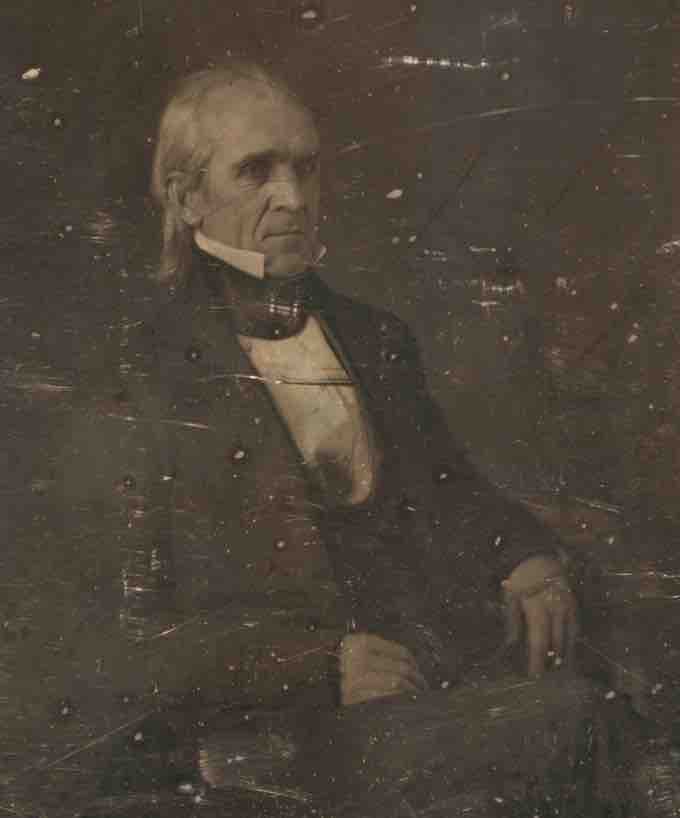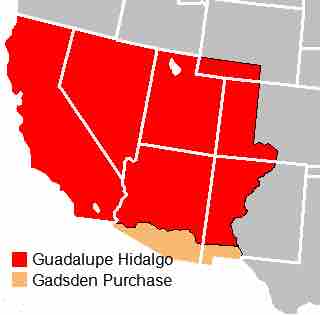President James K. Polk
James K. Polk, at age 49 the youngest president at that time to be inaugurated, set out a series of goals, two of which were explicitly related to US expansion. He intended to acquire some or all of Oregon Country from Britain, as well as California and New Mexico from Mexico. He pledged to accomplish all of these objectives in a single term. By linking acquisition of new lands in Oregon (with no slavery) and Texas (with slavery), he hoped to satisfy both the North and the South.
Polk strongly supported expansion. Democrats believed that opening up more land for yeoman farmers was critical for the success of republican virtue. Like most Southerners, he supported the annexation of Texas. To balance the interests of the North and the South, he also wanted to acquire the Oregon Country (present-day Oregon, Washington, Idaho, and British Columbia), and he sought to purchase California from Mexico.

James K. Polk
Daguerreotype of President Polk taken by Mathew Brady on February 14, 1849, near the end of his presidency.
During his presidency, many abolitionists harshly criticized Polk as an instrument of "Slave Power" and claimed that he supported the annexation of Texas, as well as the later war with Mexico, for the purpose of spreading slavery. Polk believed slavery could not exist in the territories won from Mexico but refused to endorse the Wilmot Proviso that would forbid it there.
US Expansion under President Polk
Oregon
Polk heavily pressured Britain to resolve the Oregon boundary dispute. Since 1818, the territory had been under the joint occupation and control of the United Kingdom and the United States. Previous US administrations had offered to divide the region along the 49th parallel, which was not acceptable to Britain, as they had commercial interests along the Columbia River. Polk was at first willing to compromise, but when the British again refused to accept the 49th parallel boundary proposal he broke off negotiations and returned to the Democratic "All Oregon" demand (which called for all of Oregon up to the 54–40 line that marked the southern boundary of Russian Alaska). The rallying cry "54–40 or fight!" became popular among Democrats.
Polk wanted territory, not war, so he compromised with the British Foreign Secretary, Lord Aberdeen. The Oregon Treaty of 1846 divided the Oregon Country along the 49th parallel, as in the original US proposal. Although there were many who still clamored for the entire territory, the Senate approved the treaty. By settling for the 49th parallel, Polk angered many midwestern Democrats. Many of these Democrats believed that Polk had always wanted the boundary at the 49th, and that he had fooled them into believing he wanted it at the 54th. The portion of Oregon territory the United States acquired later formed the states of Washington, Oregon, and Idaho, and parts of Montana and Wyoming.
Texas
Upon hearing of Polk's election to office in 1844, President John Tyler urged Congress to pass a joint resolution admitting Texas to the Union. Congress complied on February 28, 1845. Texas promptly accepted the offer and officially became a state on December 29, 1845. The annexation angered Mexico, which had lost Texas in 1836, and Mexican politicians had repeatedly warned that annexation would lead to war. Nevertheless, just days after the resolution passed Congress, Polk declared in his inaugural address that only Texas and the United States would decide whether to annex.
California
After the Texas annexation, Polk turned his attention to California, hoping to acquire the territory from Mexico before any European nation could do so. The main interest was San Francisco Bay, as an access point for trade with Asia. In 1845, he sent diplomat John Slidell to Mexico to purchase California and New Mexico for $24–30 million. Slidell's arrival caused political turmoil in Mexico after word leaked that he was there to purchase additional territory and not to offer compensation for the loss of Texas. The Mexicans refused to receive him, citing a technical problem with his credentials.
In January 1846, to increase pressure on Mexico to negotiate, Polk sent troops under General Zachary Taylor into the area between the Nueces River and the Rio Grande—territory that was claimed by both the United States and Mexico. This action soon led to the Mexican–American War, which the United States won. As part of the Treaty of Guadalupe Hidalgo, which ended the war, Polk achieved his goal of adding California to the United States.

Proclamation of War Against Mexico
Polk's presidential proclamation of war against Mexico.

Treaty of Guadalupe Hidalgo
The Mexican Cession (in red) was acquired through the Treaty of Guadalupe Hidalgo that ended the Mexican–American War. The Gadsden Purchase (in orange) was acquired through purchase after Polk left office.
The war had serious consequences for Polk and the Democrats, however. It gave the Whig Party a unifying message of denouncing the war as an immoral act of aggression carried out through abuse of presidential power. In the 1848 election, however, the Whigs nominated General Zachary Taylor, a war hero, and celebrated his victories. Taylor refused to criticize Polk. As a result of the strain of managing the war effort directly and in close detail, Polk's health markedly declined toward the end of his presidency.